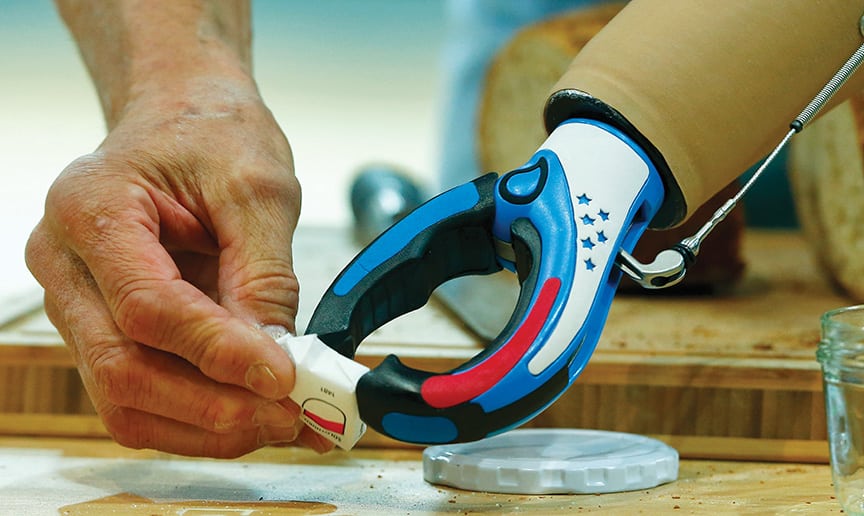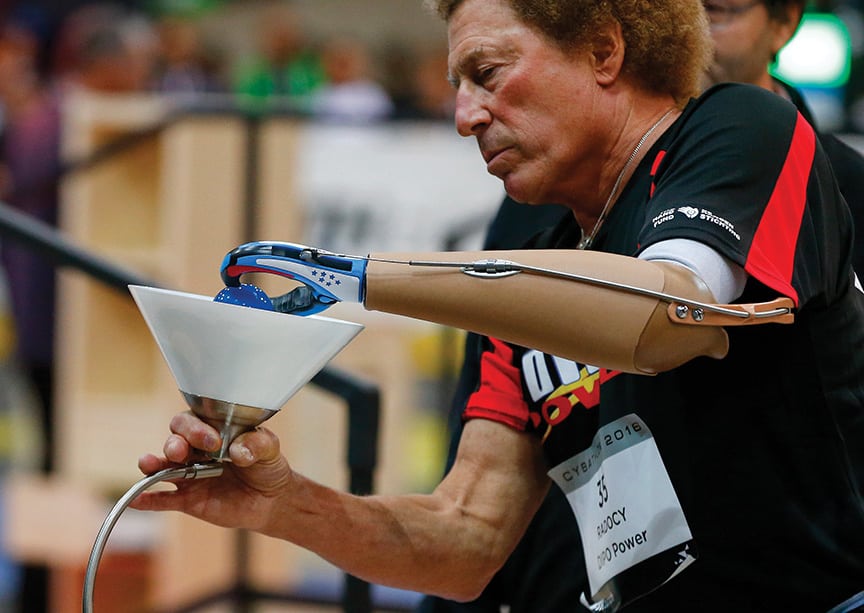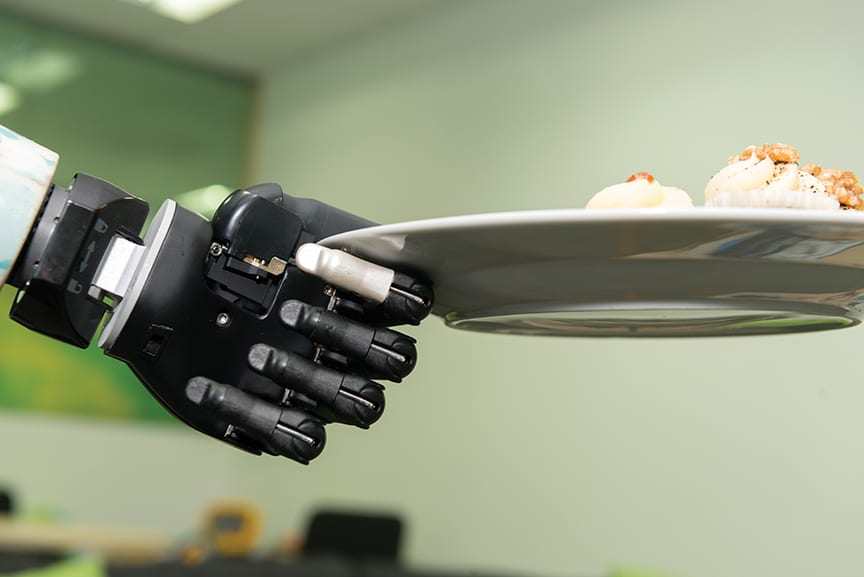POINT
By Bob Radocy
It’s time to add a dose of reality to the upper-limb (UL) prosthesis prescription. When deciding which type of prosthesis to purchase, one factor that must be contemplated is the cost-benefit ratio of the device. In a world of diminishing financial resources, tighter insurance reimbursement, and government-driven health benefits, this is especially important.
Advances in myoelectric, externally powered, and inappropriately named bionic UL technologies have been significant in the last ten to 15 years. These advances come with significant increases in prices compared to alternative solutions. Spending $50,000 or more on a below-elbow prosthesis equipped with a modern electric hand is commonplace. What you get for that $50,000 is certainly not a bionic replacement hand but a sophisticated electro-mechanical device that can replicate certain basic anatomical grasp patterns using muscle signal sensors, motors, and batteries for power. Nifty? Cool? Yes, absolutely. But does this technology function as well as a real hand? No. Does an electronic hand function as quickly and spontaneously as a modern voluntary closing (V/C) prehensor? Absolutely not.
Can you “feel” your grasp with an electric hand anything like you can with a real hand? No. Can you feel your grasp with a V/C prehensor like you can with a real hand? It’s not exactly the same, but you can “feel” and control your grasping force in a very normal, directly proportional way, like a human hand.
Can you participate in water sports or lift heavy weights with your $50,000 bionic hand? I wouldn’t recommend it. Can you swing a golf club or baseball bat? Not very well. How about pound nails using a hammer, hold and use a chisel, handle large power tools, paddle a kayak, row a boat, control a heavy wheelbarrow, or work on your car, motorcycle, or recreational vehicle? Doubtful.

How often would you have to recharge that expensive device? Probably daily. Want to go on a five-day camping trip? Leave the bionic hand at home. Also, how often do these devices require repair, and how much will those repairs cost? How long will they take? And what will you do in the meantime? Will you have to go handless?
Here’s a reality check: If you had to pay $50,000 or more for this kind of device yourself, would you do it? What else could you buy with that money instead?
So what’s the alternative? For the same investment, you can have five specialized prostheses built. You can have a high-performance, super-efficient, body-powered V/C arm and four other specialized limbs for sports or other specific activities—golf, swimming, hockey, archery, construction, welding, or woodworking—your choice.
If you want to spendyour $50,000 on one limited-function, electronic prosthetic limb (cool or not), then go for it. I understand that we all have different wants and needs. If you really want an electric hand prosthesis because it makes you feel better, or more whole, or for another reason, that is fine. That may be what is right for you. But if you want to live and experience a more flexible and active lifestyle, then remember you can have five for the price of one. Remember that there are other exciting and viable prosthetic solutions to help you perform better. Don’t get locked in a bionic box.

I’m a 67-year-old below-elbow amputee who has used a wide variety of prosthetic technology since 1971. I wear a V/C Grip 5 Evolution prehensor or alternative Grip prehensor daily, 16 hours per day on average. Additionally, I often wear a variety of activity-specific prosthetic devices. I exercise and weight condition at least three times a week. I have never purchased or worn, for any significant length of time, an electronic, myoelectric, or other externally powered prosthesis. But I am thoroughly familiar with those technologies’ capabilities. I can afford an electronic arm if I choose to wear one. An electronic or bionic hand does not meet my needs or lifestyle because of the limited performance they offer. I’m biased toward body power because of performance and reliability, and on October 8, 2016, I demonstrated this by outperforming all the best bionic arm technologies in the world at Cybathlon 2016.
I design, manufacture, and sell UL prosthetic components through TRS Prosthetics, Boulder, Colorado. I don’t like placing all my eggs in one basket; I’d never put my life on the line with only electric hand technology. I would never have just one arm—just one prosthetic arm, that is. I always travel with a spare. You owe it to yourself, your lifestyle, and your family to be prepared. I’m not going to be single-handed and you shouldn’t be either.
So, my suggestion to you is this: Do not accept the limitations of a single bionic arm in your life. You need a backup—maybe four backups. It’s your life and your decision—or it should be. Educate yourself about UL prosthetic alternatives.
The competition is on!
For more information or for free advice on your options, contact Radocy at bob@trsprosthetics.com or 800-279-1865.
Any episode of Top Chef will show you that to succeed in the kitchen, a chef must be a good planner, keep cool under pressure, and be able to adapt to unexpected situations. Notably, these are some of the same qualities amputees must possess as they navigate through life. It may come as no surprise, then, that many chefs who are amputees have found great success in their occupations.
Nicole Clark, a chef with a love of baking, has been an amputee all her life. Born three months early as a triplet, Clark had no circulation in her left arm, and she had to have it removed when she was less than 3 weeks old. Her interest in cooking took root when she was in junior high and found herself drawn to cooking shows on the Food Network. She started to practice basics like cracking eggs and opening food packages, and soon she began attending local cooking classes. By her senior year of high school, Clark was working in a cake shop with plans to enroll in a culinary arts program.
By Jeremy Farley, CPO
When choosing the level of technology for a patient’s prosthesis, it’s important to remember that there is no best technology for everyone, only what is best for that individual. Despite all the advancements in prosthetic tools and equipment, no device can duplicate what the human hand can do. Every system has strengths and weaknesses. A person’s goals should be taken into account when deciding what features and tools are going to be built into a prosthesis. We have to be certain that those features help that person achieve his or her goals.
Body-powered systems require the use of a harness and cable to transmit the motion of the shoulders to operate the terminal device, which may be a prosthetic hand, hook, or prehensor. This means that the grip force that someone can generate is limited by the strength and motion available in the shoulders. There are numerous reasons that strength and motion may be limited. Externally powered systems, often called bionic or myoelectric, don’t rely on a harness and cable system but instead rely on batteries and a motor to generate grip strength. This means that the grip force in the hand, hook, or prehensor is not limited by the strength and motion available in the upper body. With an externally powered system, users also don’t have to worry about fatigue from repeatedly generating high amounts of grip force.
In body-powered systems, the harness and cable controls the terminal device and its position. With an externally powered system, the harness and cable can be eliminated by using socket designs that suspend the prosthesis from an individual’s residual limb. Without the harness, there is less concern with overuse of the shoulders to drive the prosthesis and a reduced risk to sensitive anatomy, such as the armpits, which the harness can press on. This allows for a more comfortable prosthesis that is more likely to be worn and used throughout the day.

A disadvantage of body-powered hands is that they are inefficient; a rather large force is needed at the harness to operate them. Externally powered terminal devices don’t have this issue; their grip force is independent of a harness system.
Although prosthetic hooks, hands, and prehensors vary in their functionality, prosthetic hands have an aesthetic advantage. Prosthetic hands, especially the newer multigrip hands, appear closer in shape to biological hands. This can help draw less attention to an individual with a prosthesis.
There are a few options in externally powered multigrip prosthetic hands, and all of them offer several ways to hold on to objects. The user can choose a lateral or key grip to hold onto a plate or notepad, a pinch grip to pick up small objects, or grasp larger objects with the entire hand and let the digits conform to the objects’ individual shape to get a better hold. The ability to choose among different grip patterns means that less accommodation is needed to get the prosthesis into a useful position. The arm does not have to “wing” out or be rotated at an odd angle to grasp an object. The ability of multigrip hands to change grips also makes them suitable for a wider range of tasks. This means the hands don’t have to be swapped out for different devices as often to accomplish daily tasks.

The choices available for building externally powered systems are as varied as those for body-powered systems. There are various types of hooks, prehensors, and hands with single grip or multigrip capability and wrists that can rotate or flex. The prosthesis can be controlled several ways: muscle contractions, switches, touch pads, or a combination. An externally powered prosthesis can be controlled by a single switch if necessary. It is even possible to use pattern recognition to control a prosthesis. Pattern recognition allows for the most intuitive and easy type of control available, using the body’s natural motions to control the prosthesis.
Technology for externally powered prostheses is also improving rapidly. There are new types of surgeries, such as targeted muscle reinnervation and osseo-integration that make the prosthesis easier to use. Pattern recognition is getting better at learning how we move and using that natural motion to control the prosthesis. Motors continue to get smaller and stronger. Improved batteries provide more power and longer life. Even prosthetic socket designs continue to improve, moving from traditional body-powered designs to being optimized for externally powered systems.
Every prosthetic system must be designed with the user’s goals in mind. One component might fit into the needs and goals of a certain individual, while being totally inappropriate for another. The good news is that there are options. Externally powered prostheses provide a great deal of flexibility, allowing the system to be customized to meet the needs of the individual. Technology continues to advance, and prosthetic systems are becoming faster, stronger, and more intuitive. There is no “best” option that can be applied to all upper-limb amputees, only what is best for one person and what that individual wants to achieve.
For more information, contact Touch Bionics at customersupportus@touchbionics.com.



